Inflight Magazine of Brussels Airlines
Welcome to the Inflight Magazine of Brussels Airlines
Going underground
 From bars and restaurants to hotels and hammams, Heidi Fuller-love discovers it’s cool to go underground near Malaga in sunny, southern Spain
From bars and restaurants to hotels and hammams, Heidi Fuller-love discovers it’s cool to go underground near Malaga in sunny, southern Spain
Cave-dwelling hobbit Bilbo Baggins would have a ball in southern Spain. Sent underground thousands of years ago – not by a love of dirt roofs but by the exigencies of a sausage-sizzling climate – Iberia’s largest troglodyte population is concentrated within hills once used as scenic backdrops for Sergio Leone’s spaghetti westerns, which run from Granada to Jaen, Almeria and Albacete.
Long before The Good, the Bad and the Ugly hit town, however, low-browed local cavemen were digging holes out of the soft tufa rock with animal bones. By the time the Moors came on the scene, in 755AD, and introduced plumbing, burrows had become the region’s principal form of housing.
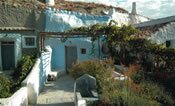 A pretty primitive life, you might think. Well, think again. “Caves are a lot better than you might imagine,” says Rob Ansel, who owns a two-bed grotto near Guadix. “There’s no problem with noisy neighbours and if you want more rooms, you just dig.”
A pretty primitive life, you might think. Well, think again. “Caves are a lot better than you might imagine,” says Rob Ansel, who owns a two-bed grotto near Guadix. “There’s no problem with noisy neighbours and if you want more rooms, you just dig.”
These hollowed-out hills are now home to a host of eclectic subterranean entertainment venues, so here’s a pick of the best. As Rob says: “Why should hobbits have all the fun?”
Swankiest cave district
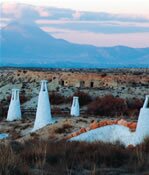 Hollywood stars Anthony (Zorba) Quinn, Yul Brynner and Ingrid Bergman flocked to the Sacromonte (‘Sacred Mountain’) in Granada to be photographed with the flamboyantly robed flamenco gypsies who lived in the caves. More recent celebs to visit the grottos include footballer David Beckham and ex-US president Bill Clinton.
Hollywood stars Anthony (Zorba) Quinn, Yul Brynner and Ingrid Bergman flocked to the Sacromonte (‘Sacred Mountain’) in Granada to be photographed with the flamboyantly robed flamenco gypsies who lived in the caves. More recent celebs to visit the grottos include footballer David Beckham and ex-US president Bill Clinton.
To grab a classic slice of this quarter, renowned for all-night Zambra flamenco fests, head for La Rocío (70 Camino del Sacromonte, tel. ), where dancers perform rousing steps beneath a ceiling curved like a gypsy roulotte, or caravan, hung with burnished pots and pans. For an insider’s view, skip up the hill to the smaller cave bars to see improvised flamenco sessions called ‘juergas’, then follow the hip crowd to El Camborio (47 Camino del Sacromonte, tel. ), a labyrinthine cave disco with dance floors, bars, womb-like chill-out rooms and a laidback ambience fired by the latest Spanish dance tunes.
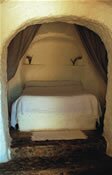 While flamenco vampires sleep off their heavy night, culture vultures should rise early and make a beeline for the world’s first gypsy museum. Housed in three connecting caves, the recently inaugurated Museo de la Mujer Gitana (La Chumbera, 107 Camino del Sacromonte, tel. ) sheds new light on the role of gypsy women in world history and culture. In a dim cave dedicated to gypsy mysticism, you can also have your palm read for a piece of silver or find out more about the art of healing with herbs.
While flamenco vampires sleep off their heavy night, culture vultures should rise early and make a beeline for the world’s first gypsy museum. Housed in three connecting caves, the recently inaugurated Museo de la Mujer Gitana (La Chumbera, 107 Camino del Sacromonte, tel. ) sheds new light on the role of gypsy women in world history and culture. In a dim cave dedicated to gypsy mysticism, you can also have your palm read for a piece of silver or find out more about the art of healing with herbs.
Hobbit HQ
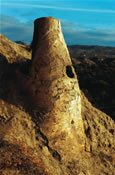 Seen from afar, Guadix’s barrio del cuevas – its cave district – resembles a mole-blasted field. And it doesn’t look much better close up. Only smoke curling from the man-high chimney pots scattered over this square mile of lumps and tussocks tells you that 2,000 people are down there somewhere doing their homework, watching TV or feeding the dog.
Seen from afar, Guadix’s barrio del cuevas – its cave district – resembles a mole-blasted field. And it doesn’t look much better close up. Only smoke curling from the man-high chimney pots scattered over this square mile of lumps and tussocks tells you that 2,000 people are down there somewhere doing their homework, watching TV or feeding the dog.
If your pack’s heavy or you’re feeling lazy, hop on the Guadix Express (Calle Maria de Mendoza, tel. ) and let the train take the strain of trundling you around this conurbation, which boasts the biggest concentration of cave houses in southern Spain. But if you want to get your own fix on the lifestyle of this subterranean town, take a look around on foot, then head for the cave museum near the church. Check out the pointy cavers’ pickaxes and tackle for slaughtering pigs, before taking a tour of one of half-a dozen local burrows that will open their doors for you like magic if you pull out a fistful of euros.
Best underground feeding
Full of romantic nooks and crannies, the Cueva Alcadima (Ctra Fuencaliente, tel. ), is a convivial cave bar/ restaurant carved out of a hill overlooking the town of Huescar. It attracts a chic crowd who come here to sup on tasty Moroccan-Spanish fusion food and an exotic selection of spiced teas.
For something a lot quirkier, head for the British-run Curry Cave (El Margen, tel. ), where you can snuggle up in an underground booth decorated with elephant tusks and prints of the Taj Mahal and order an excellent value Indian buffet. A selection of starters and main courses, including a vegetarian curry plus all the beer you can drink, costs just €15.
Popular with Granada’s city slickers and serving a selection of the region’s best signature dishes, La Chumbera (107 Camino del Sacromonte, tel. ) is a series of cosy railway carriage-like caves with domed ceilings. You sit elbow-to-elbow with your neighbours as you sup on thymeflavoured home-bred pork, moist black pudding and other succulent house specialities.
Subterranean slumbers
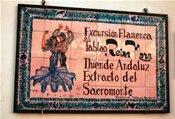 If you’re tempted by the new troglodyte trend but scared of finding stone age facilities, head for Las Cuevas Pedro Antonio de Alarcón (Barriada San Torcuato, Guadix, tel. ), a sumptuously renovated cave complex with a swimming pool, Jacuzzi and restaurant. Here you can play at being Fred Flintstone while watching satellite TV in an underground den.
If you’re tempted by the new troglodyte trend but scared of finding stone age facilities, head for Las Cuevas Pedro Antonio de Alarcón (Barriada San Torcuato, Guadix, tel. ), a sumptuously renovated cave complex with a swimming pool, Jacuzzi and restaurant. Here you can play at being Fred Flintstone while watching satellite TV in an underground den.
For a spot of soothing cocooning, grab a loincloth and get down to Cuevas Al Jatib (Camino de Oria, Baza, tel. , aljatib.com). This complex of self-catering caves and hotel rooms, surrounded by a hikers’ paradise of wild countryside, has a cave hammam where you can luxuriate in a vaulted pool, then saunter to the grotto next door for a toning massage before chilling out with a glass of mint tea in the hotel’s troglodyte teteria (tearoom).
Want to shake the city dust from your hair? Las Casas Cuevas (Galera, tel. ), a remote Swiss cheese of caves 3,000 feet above Almeria’s coastline, attracts an eco-aware crowd. Grotto-owner Miguel Rodriguez, who uses a team of donkeys to carry clients and baggage up to this subterranean pueblo, tells us: “Galera is a wonderful place. Even when temperatures are 40°C plus, our caves are 18°C inside.”
Didn’t we tell you caves were cool?
FR » Au cœur de la terre
Que ce soient dans les bars, les restaurants, les hôtels ou les hammams, voici quelques raisons pour lesquelles il est si agréable d’aller sous terre près de Malaga, dans le Sud ensoleillé de l’Espagne.
A l’origine, les hommes des cavernes de l’endroit creusaient des trous dans le tuf, la roche poreuse, créant des terriers qui devinrent la principale forme d’habitat de la région. Ces collines creusées abritent aujourd’hui une série de lieux de loisirs, éclectiques et souterrains. A vous de choisir celui qui vous ravira le plus.
Pour les fêtes Zambra de flamenco, qui durent toute la nuit, allez à La Rocío (70 Camino del Sacromonte). Cherchez les petits bars dans les grottes pour des sessions improvisées de flamenco (juergas). El Camborio (47 Camino del Sacromonte) est un endroit fantastique pour la soirée, un bar disco labyrinthique. Visitez aussi le premier musée gitan au monde Museo de la Mujer Gitana (La Chumbera, 107 Camino del Sacromonte)
Le barrio del cuevas à Guadix concentre le plus grand nombre de maisons souterraines du Sud de l’Espagne. Découvrez ce noyau urbain à pied – allez jusqu’au musée souterrain près de l’église et faites un tour des constructions particulières de l’endroit ou encore montez dans le Guadix Express (Calle Maria de Mendoza) pour un tour en train.
Envie de dîner sous terre ? Essayez le bar/restaurant Cueva Alcadima (Ctra Fuencaliente) sculpté dans la roche de la colline qui surplombe la ville de Huescar. L’étrange Curry Cave (El Margen) de son côté, propose un buffet indien pour un excellent rapport qualité/prix.
Pour un sommeil profond, Las Cuevas Pedro Antonio de Alarcón (Barriada San Torcuato, Guadix) est un complexe souterrain somptueusement rénové avec piscine, Jacuzzi et restaurant. Vous pouvez aussi séjourner à Las Casas Cuevas (Galera) qui attire un public écoconscient, et qui choisit de venir ici à la recherche de fraîcheur, loin de la foule déchaînée.
NL » Ondergronds
De vele bars, restaurants, hotels en hamams zijn alvast de perfecte ingrediënten voor een ondergronds avontuur dicht bij Malaga, in het zonnige zuiden van Spanje.
In een ver verleden groeven holbewoners gangen en grotten in de zachte tufstenen, om in te wonen. Die uitgeholde heuvels huisvesten nu ondergrondse ontmoetingsplaatsen. Een greep uit het aanbod…
Als je de nacht wil wegdansen op Zambraflamenco, moet je naar La Rocío (70 Camino del Sacromonte). In de kleinere grotbars vinden dan weer geïmproviseerde flamencosessies (juergas) plaats. Wie naar de discotheek wil, moet beslist naar El Camborio (47 Camino del Sacromonte), een soort ondergronds labyrint. Breng zeker ook een bezoek aan ‘s werelds eerste zigeunermuseum Museo de la Mujer Gitana (La Chumbera, 107 Camino del Sacromonte).
In de barrio del cuevas van Guadix vind je de grootste concentratie grotwoningen in Zuid-Spanje. Die agglomeratie bezoek je best te voet. Ga naar het grotmuseum nabij de kerk, bezoek een paar lokale grotten of maak een treinrit met de Guadix Express (Calle Maria de Mendoza).
Ook ondergronds eten kan. Een aanrader is bar/restaurant Cueva Alcadima (Ctra Fuencaliente), uitgehouwen uit een heuvel met zicht op de stad Huescar. De originele Curry Cave (El Margen) vergast je dan weer op een uitstekend Indisch buffet.
Voor een goede nachtrust kun je terecht in Las Cuevas Pedro Antonio de Alarcón (Barriada San Torcuato, Guadix), een prachtig gerenoveerd grottencomplex met een restaurant, zwembad en jacuzzi. Er is ook nog Las Casas Cuevas (Galera), populair bij ecoreizigers die er tot rust willen komen, ver weg van alle drukte.
Leave a Reply
